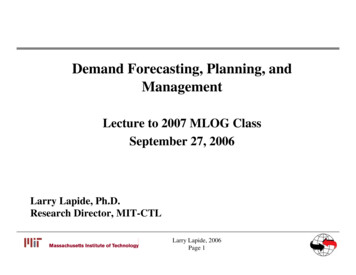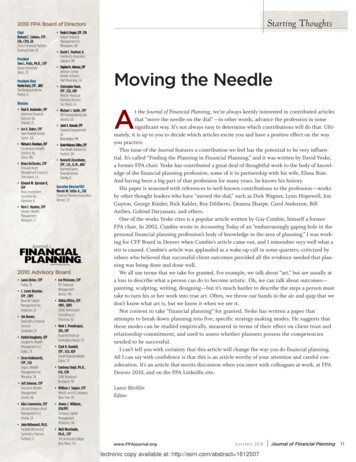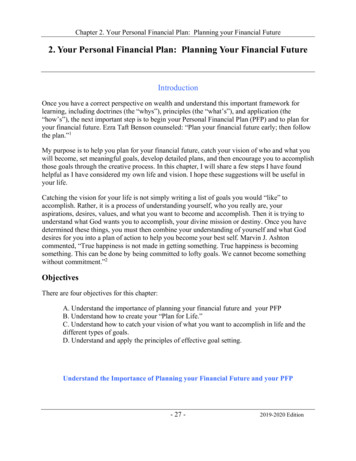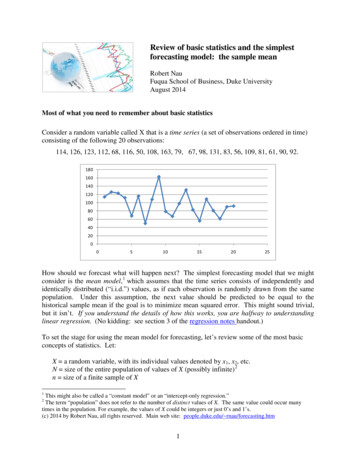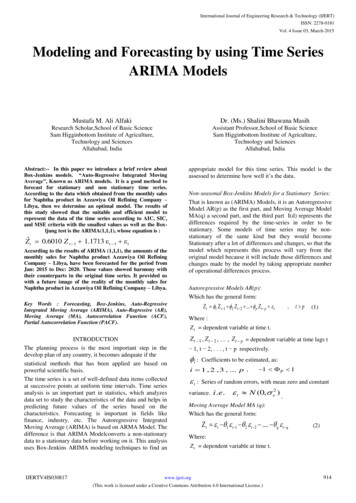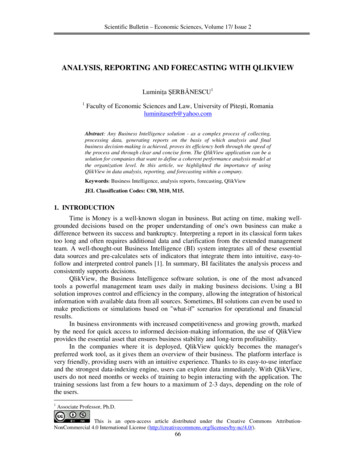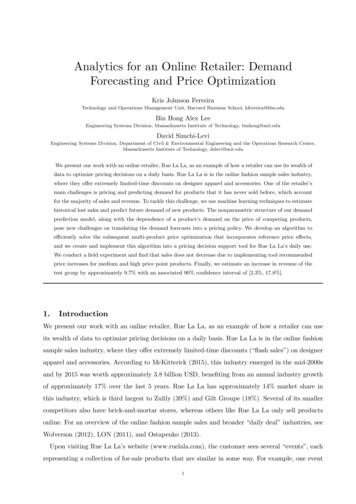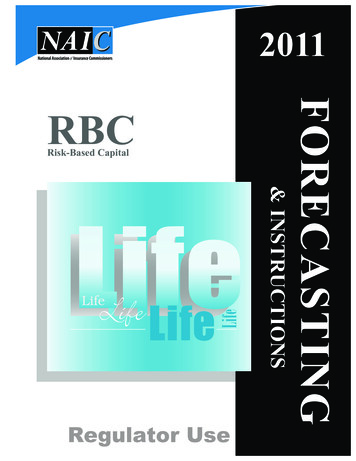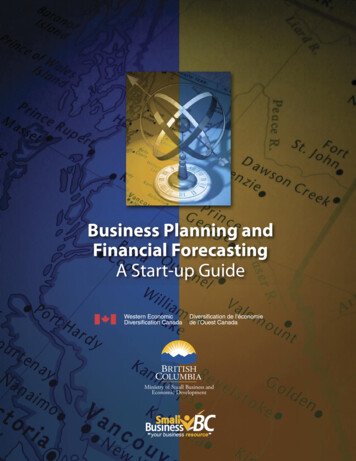
Transcription
Business Planning andFinancial ForecastingA Start-up GuideMinistry of Small Business andEconomic Development
Ministry of Small Business andEconomic Development
Business Planning andFinancial ForecastingA Start-up GuideWestern Economic Diversification Canada and theMinistry of Small Business and Economic Development are pleased to publishBusiness Planning and Financial Forecasting: A Guide for Business Start-Up.This web-based guide is available on Small Business BC’s website by clicking onSmall Business Guides at www.smallbusinessbc.ca.For all your other business information needs go to British Columbia’s awardwinning resource centre for business information and planning tools.Small Business BCSuite 82, 601 West Cordova, Vancouver, BC V6B 1G1Phone: Toll Free 1 800 667 2272In Greater Vancouver 604 775-5525Fax: 604 775-5520e-mail: visit www.smallbusinessbc.ca/emailwebsite: www.smallbusinessbc.ca
The Business PlanIntroductionYou want to start a business – or expand your existing business. You have a greatidea, super attitude and the entrepreneurial spirit. So you head down to your localbank or financial institution; you sit down in front of the credit manager and startto explain this brilliant idea when she interrupts you: “That sounds great, but whereis your business plan?”This scenario is played out every day in Canada – people with ideas who wantto plunge into business without having done a business plan. The purpose of thisguide is to explain in simple terms the business plan concept and to show you howto put your own plan together.A Start-Up Guide leads entrepreneurs through the business planning process.By describing everything from Vision and Mission to Operational Strategies, theGuide provides an easy to read description of your new business concept. Theaffiliated “Financial Planning Template” helps entrepreneurs assemble their StartingBalance Sheet, Pro-Forma Income Statement and first year Cash Flow Forecast. ThisMS Excel template is available at cialTemplate.XLT. There is plenty of help available to you including coursesfrom your local college or school board and of course the services and informationresources of Small Business BC, including the Interactive Business Planner located atwww.smallbusinessbc.ca/ibp.Why do a Business Plan?Your own thinking process is solidified through the planningprocess.The planning outline provided in this guide leads you through a series of questionsand issues that you should consider when thinking about your business. Rememberthat you are an investor in your own business. You are the first person who must haveconfidence in the validity of your business concept.Your bank or financial institution will need to be convinced of theviability of your business, or your business expansion.The business plan is a communications tool to inform and influence the reader towardssome action – providing a loan, extending credit or investing in your business.Your business plan provides some guideposts in running yourbusiness.You will set goals and then, once you are in business, you can measure those goalsagainst the actual performance. Goals should be specific, measurable, achievable,realistic and time limited – SMART.A Start-up Guide 1
What is in a business planThere seem to be as many kinds of business plans as there are businessplanning guides. There are two ways to look at the business plan: by stage ofdevelopment, and by target reader. Under the stage of development, thereare generally two ways to divide the planning style: start-up plans and plans forongoing businesses. Under the target reader there are also two ways to look atthe plan: an inside reader and an outside reader.Graphically, we can look at it this way:Existing BusinessLoan or InvestmentStrategic PlanLoan ProposalOperational Start-upExternalInternalStage ofDevelopmentStart-upTarget ReaderThere are of course many variations on the general categories. (For example, arapidly growing business requires a slightly different emphasis for both its strategicand loan / investment plan.) Although there are different plans and different readers,there are similarities in each of the four plans – including the financial forecast, whichis common to all business plans.A business plan geared to an external reader is written with a specific objectivein mind – usually a loan or an investment. Before writing the external plan, you asthe business owner must believe in your business. After all, how can you convince abank or financial institution to lend, or an investor to invest, unless you are personallyconvinced of the validity of the business?A business plan geared to the internal reader serves two purposes. It is a roadmap for taking the business in a particular direction. It is also a litmus test for thebusiness. Setting goals and objectives is one thing, but determining the stepsneeded to accomplish these goals is quite another. The planning process allowsthe entrepreneur to determine what might or might not work. For example, abusiness owner may research the idea of opening a chain of stores only to discoverthat franchising is a more effective way to expand the business. Likewise, in astart-up situation, an entrepreneur may discover during her market research thather hometown is not large enough to provide a sustainable market for her chosenendeavor. She can then consider a different type of business, or start her businessin a different location.2 Business Planning and Financial Forecasting
This GuideThis guide to Business Planning and Financial Forecasting is written for the Start-upBusiness to communicate with an external reader, with special emphasis on banks orfinancial institutions.Be clear and informYou cannot assume that the reader of your plan knows anything beyond whatyou have stated in the plan. You may know what you mean, but have you clearlyexplained it to the reader? As you go through this outline, constantly ask yourselfif you are making yourself clear to a reader who is not familiar with your industry oryour business. Your business plan may be your only representation to an outside partysuch as a bank or financial institution! In most business start-up situations, the lenderis basing their decision on the viability of the business and the character of theentrepreneur. Your business plan not only represents your business it representsyou.Here are a few tips on the actual writing of the plan:Do’s Try to keep it fewer than twenty pages, exclusive of the appendix. Use bullet points and numbered lists wherever possible. Use, but do not overuse, graphs, diagrams and photographs. Have a neutral third party read the plan – especially someone unfamiliar withyour industry. Include a table of contents and page numbers in your plan.Don’ts Avoid big words and long sentences. They only serve to confuse the reader. Don’t use technical words and unnecessary jargon. If you need to introduce atechnical term, then you should define it. Avoid using acronyms and initials to express words is another common error.You may be very familiar with the acronym but your reader might not. If anacronym has become as common as a word, such as SCUBA or LASER, then usethem. If they are still technical, such as URL then you may need to define theacronym and its meaning.Planning OutlineIntroduction Business Concept Plan Goals and Objectives Management / OwnershipProducts & Services Product / Service Mix Product / Service RisksMarket Research Industry Research Customer ResearchMarketing Strategies Pricing Physical Distribution PromotionOperations Process Procurement Personnel (Human Resources) Legal and AdministrativeFinance Breakeven Starting Balance Sheet Pro-forma Income Statement Cash Flow Forecast Program and FinanceOutlining your business planThere are many different outlines you can use for your business plan. The followingoutline is designed specifically for the reader. A good plan for an outside readeranticipates and answers the readers concerns and important issues. To see a sampleplan, go to: www.smallbusinessbc.ca.A Start-up Guide 3
Elements of a Business PlanPurpose: The purpose of the executive summary is to get the readers attention bysummarizing the key elements of the business plan. It must be short, to the point andvery well written.This is arguably the most important part of the business plan. The Introduction mustmake your reader want to keep reading. It is a good idea to write as much of theIntroduction as you can at the outset of the planning process. This initial writing willhelp you to focus your attention on the goals of the plan. You should then rewritethe Introduction after you have completed the rest of the business plan. This waythe specifics of the plan, and the changes made during the planning process areaccounted for. You are addressing the issues of what you do, where you are goingin the short term and what you want from the reader of the plan. This section of theplan should be two to three pages long.Business Concept Describe what your business does in general terms. Include your mission or vision statement. Describe what differentiates your business from others. This is important tothe reader, as they want to know how your business will be able to create newcustomers. What do you offer that will take customers away from competitors? Briefly describe your business history if applicable. Provide any other information that will excite the reader about your business.Goals & Objectives Tell the reader what you want (e.g. a business loan for a specific amount topurchase equipment). State your sales, production and profit goals. Be specific in amount and timeline. If this is for a bank loan, comment on goals such as anticipated time to achievea positive cash flow and the ability to service debt. (Note you cannot completethis section until the rest of the plan is complete.)Management Ownership Briefly describe the technical qualifications of each principal in this enterprise. Briefly describe the business qualifications of each principal in this enterprise. Tell the reader your business structure (i.e. proprietorship, partnership, andincorporation). Provide a fact sheet with contact information such as name, address, telephone,e-mail, etc.4 Business Planning and Financial Forecasting
Products and ServicesPurpose: The purpose of the product/service section is to detail exactly what yourbusiness does for the customer and what makes these offerings desirable.Product Oriented Businesses Describe each product you sell. The combination of products is yourproduct mix. If you cannot list each product, break the business down into logicalcategories. Describe the key product features, and how your products are different fromthose of your competition. (Functionality, durability, ease of use, etc). Describe product protection such as patents, copyrights and trademarks.Service Businesses Describe each type of service you offer (be specific). Describe the service features in terms important to the customer. Describe any service protection such as copyrights or trademarks.Product RisksIf there are any risks associated with your product or service such as product liability,professional liability, or ease of duplication by competition, state them and describehow you will mitigate these risks.Market ResearchPurpose: The purpose of the Industry and Market Research section is to prove thatthe market is large enough in your area to support the survival and growth of yourbusiness.Industry ResearchDescribe your industry. If you are in a new industry, or an industry not well knownto a reader, this will be a fairly comprehensive section. A better known industryrequires less explanation. Describe the state of the industry. Is it a new industry, growth industry,competitive industry, or a stable mature industry? Document industry trends on a local, national or world scale. Sales, numberof customers, number of units sold, trends in related industries are all goodindustry indicators. Describe the key customers for your specific industry. Provide other national/international economic indicators that encourage thehealth of your industry. Examine risks to the industry caused by legislation, technological change orany threat to the industry as a whole.A Start-up Guide 5
Target Market - Customer ResearchThe Target Market is the groupings of consumers or businesses most likely topurchase your products or services. The first group you plan to target is yourPrimary Target Market; the second is your Secondary Target Market. It is veryimportant that you understand your target markets after all, these are thecustomers you need to keep happy!Consumer MarketsBusiness MarketsWho is the customer? (Provideboth the description and theinformation in this section.) Age Gender Income Family StatusBe sure to include how manycustomers there are in eachgrouping. Industry Type Size of Customer Annual SalesEstimate the number of companiesusing directories or Yellow Pages.Where is the customer?The geography of business toTarget the geographic radius ofyour customer base by city, region business markets tends to be largerthan consumer markets.province or country.When do they buy?Is there a particularly busy season If you are selling to seasonalfor your product or service?businesses, the timing can beeverything. (e.g. wholesaling)What do they buy? Necessity Luxury Item High involvement/Big ticket Low involvement/consumable Inventory Item(e.g. item that is resold) Capital Item Consumable ItemWhy do they buy?How does your product or servicehelp the consumer?How does your product enhancethe performance of the customers’business?How much do they buy?Determine how much is spent onyour product by your customers.Estimate the commercialexpenditure by the industries inyour target area.Note: If you are using indirect distribution, it may be necessary to describe both yourcustome
Outlining your business plan There are many different outlines you can use for your business plan. The following outline is designed specifically for the reader. A good plan for an outside reader anticipates and answers the readers concerns and important issues. To see a sample plan, go to: www.smallbusinessbc.ca. Planning Outline Introduction
